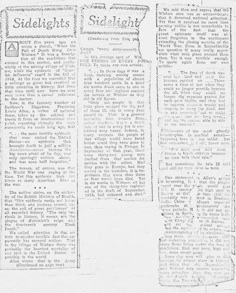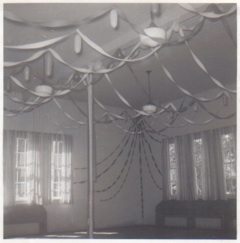Originally this was a 2 story, 4 room school house, operating from 1928 until 1952.
The school taught 1-8th grades, which was approximately 175 students per year. The average class had 10-15 students within. The grades ran paired 1st with 2nd, 3rd with 4th, etc. After the schools closing, students were bussed to West Side School in Reynoldsville.
Sam Early was the principal.
Some teachers included; Ira Bailey, Betty Mitchell, Thomas Brown, and Verda Yount. Many teachers were boarded at the mine foreman's quarters. This home has since been replaced by the Veitz/Tomasura home beside the old Tavern.
1918 the Spanish Flu outbreak took half of the population due to lack of treatment available for the Italian population. The school was converted into a hospital to care for the ill that October. Wishaw had one of the worst casualty levels in the entire country, one in every four died. The epidemic made headlines entitled "When the Pall of Death Hung over Wishaw." Five years later a follow up article was published called "Sidelights."
Newspaper Article
1923
“Sidelights” the follow-up article to “When the Pall of Death Hung Over Wishaw.”

Now, in the January number of Scribner’s Magazine, Fredrick Lewis Allen, a writer of national fame, takes up the subject and treats it from an international viewpoint, repeating virtually the very statement we made long ago, that
‘...the most terrific epidemic that ever visited the United States - an epidemic that brought death to half a million Americans - never became the big news event of its day, was only sparingly written about, and was soon half forgotten.”
The reason, of course, was that the world war was raging at the time. Yet this epidemic took ten times as many American lives as the war.
The author states, on the authority of the British Ministry of Health, that “this epidemic ranks not less than third, and perhaps second, up on the roll of great pestilences of all recorded history. “The only two rivals in history, it seems, are the plague of Justinian’s reign and the fourteenth century Black Death.”
We called attention in that article to another terrible fact that apparently has escaped notice: That in the village of Wishaw there was probably the heaviest mortality of any spot in the United States, or possibly in the world.
Allen states that in the Army Camps, “every sixty-seventh [soldier] died.”
In this scourge spot of Wishaw ONE PERSON IN EVERY FOUR DIED. To quote our own article:
“...In these days it was a busy, thriving mining center with a population of almost four hundred souls. In a brief six weeks death came to one in every four and orphans roamed the streets of Wishaw as they did in old Karan.
“Only ten people in that little place escaped the flu, and of those ill, one in every four passed on. That is a greater mortality than results from actual warfare, [usually] a death rate of one in every ten is considered very heavy. Indeed, in many respects the people of that village would have fared better could they have gone to war, then raging in Europe. In September of that year,there were thirty-two young men drafted from that section for service with the colors. Had they gone to Europe, had they served in the trenches, it is improbable that more than three or four would have died. Yet in six weeks in Wishaw, all but one of the thirty-two registered in the draft of September, 1918, had sickened and died.”
We said then and repeat that the Wishaw case was so extraordinary that it deserves national attention Yet that it received no more than [paining] notice is not remarkable in face of the fact that the great epidemic itself was almost forgotten in the excitement attending the closing months of the World War. Even in Reynoldsville are question if many really appreciate what took place around them then. Yet it was terrible enough. To quote again from our own article:
“...The fear of death was over the land and only the bravest carried on ...There came a time at last when they could no longer provide hearses for all, when they could no longer dig separate graves for each poor victim, and they had to impress [ ] trucks and wagons to carry the dead, and in one cemetery had to make mass graves just [ ] long [ ] and lay the caskets side by side at the bottom.”
This - one of the most ghastly catastrophes in medical annals - happened here in our midst. Yes few remember, and still fewer care.
“For most men and most things is black oblivion because no man tells their tale.”
But sometimes the tale IS told and still no man [ ] to note.
One statement in Allen’s article is interesting. It is that the plague raged over the whole world that fall. It reached it’s high spot in [ ] at the same time that the mortality was highest in Bombay, India. China and Japan reported outbreaks at approximately the same periods. [ ] it did not originate in Spain, as its name ..... it did not spare those living under the....Rich and poor, ....., were swept away.
Some day men will give to this [ ] its proper place in history, and when they do Reynoldsville and Wishaw may receive somewhat more attention than they now get in the State’s booklet: Pennsylvania Has Everything.”

The school was the main hub of Homecomings. It also served as the starting point of the soap box derby races, officiated by the State Police.
The sportsmen bought the school in the late 40’s early 50’s and removed the top floor, converting the building to a Community Center. The building never had indoor plumbing, and was sided with blue shingles. The outhouses remain in shambles to date.

In the fall of 1992, the building was demolished and the debris burned.











